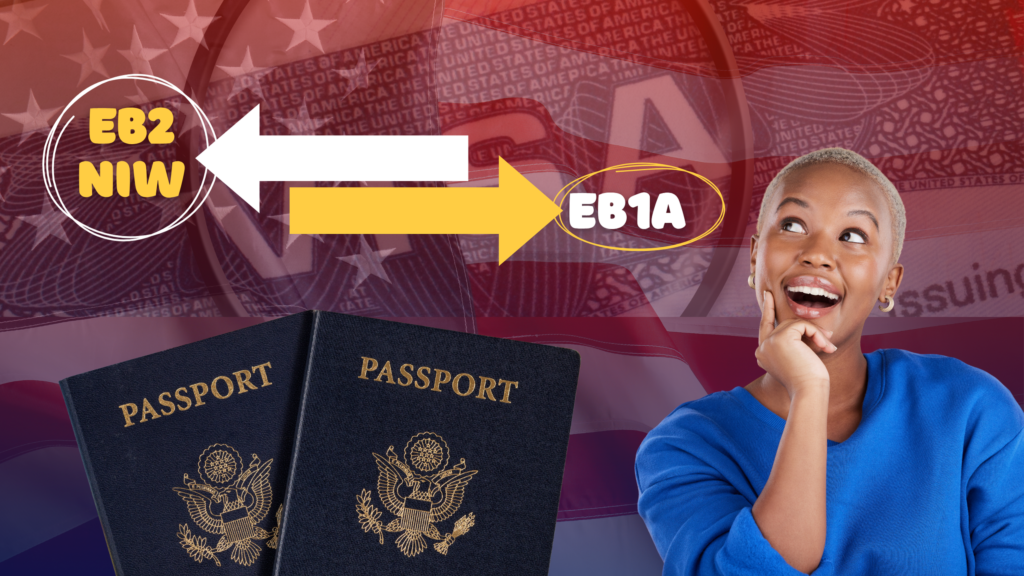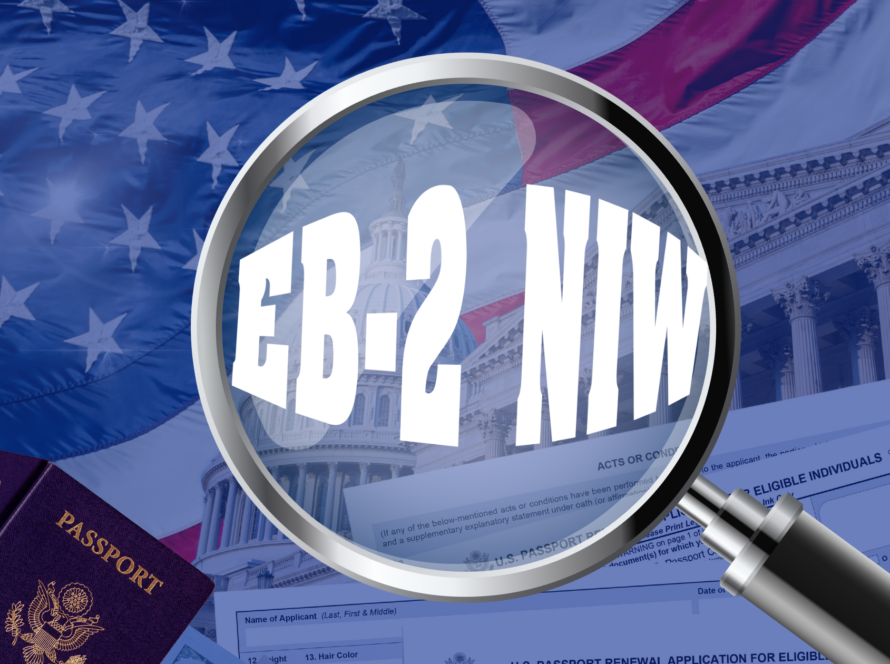
If you’re a highly skilled professional in the U.S., you may be wondering how to move from EB2 NIW to EB1A without delays or RFEs. Simply put, the process requires careful evaluation of your achievements, organizing strong evidence, securing credible recommendation letters, and strategically timing your petition. By preparing thoroughly and addressing common pitfalls upfront, you can transition smoothly to EB1A, which often offers faster green card processing and stronger recognition for your work.
In this article, we’ll break down the process step by step, cover practical tips, highlight recent trends, and answer common questions so you can confidently navigate your EB2 NIW to EB1A journey.
Understanding EB2 NIW and EB1A
EB2 NIW (National Interest Waiver) allows individuals with advanced degrees or exceptional ability to self-petition for a green card if their work is in the national interest of the U.S. The main advantage is that it bypasses the labor certification process, which normally requires employer sponsorship.
EB1A (Extraordinary Ability) is for individuals who have achieved a high level of recognition in their field. EB1A applicants must demonstrate extraordinary ability, which includes national or international acclaim and evidence that they are among the top individuals in their field. EB1A petitions generally have faster processing times and higher priority in the visa bulletin.
Many professionals prefer EB1A because the EB1A recognizes exceptional talent and achievements more prominently and can potentially speed up green card processing. This is particularly appealing for applicants from countries with long EB2 backlogs, such as India or China, where waiting times for green cards can be several years. For individuals whose work has received strong recognition in their field, upgrading to EB1A can provide both faster processing and more flexibility in their career options.
Why Consider Moving from EB2 NIW to EB1A?
Many professionals consider the transition because:
- Faster green card processing: Quicker review of EB1A petitions compared to EB2 NIW
- Stronger immigration profile: EB1A is recognized for extraordinary ability and top-level achievement.
- No job offer required: You can self-petition without being tied to an employer.
- Visa bulletin advantage: EB1A priority dates are current or in the close future for most countries
For example, a researcher from India on EB2 NIW might face multi-year wait times due to backlogs. Filing EB1A with strong evidence could reduce this wait dramatically, potentially allowing faster adjustment of status or green card approval.
Steps to Move from EB2 NIW to EB1A Without Delays
1. Assess Your EB1A Eligibility
Before filing, it’s crucial to critically evaluate whether your achievements meet EB1A standards of extraordinary ability. USCIS looks at evidence demonstrating that you are among the top professionals in your field. Key areas include:
- Major national or international awards: These could be prestigious prizes, research awards, or industry recognition.
- Publications, citations, and media coverage: Articles in reputable journals, citations, or interviews highlighting your work.
- Original contributions of major significance: Innovations, patents, or projects that have a measurable impact in your field.
- Membership in selective associations: Organizations that require exceptional achievements for membership.
- Leadership or critical roles in distinguished organizations: Positions where your contribution drives major outcomes or decisions.
Pro tip: Create a detailed checklist comparing your achievements with USCIS EB1A criteria. Identify gaps early so you can strengthen your portfolio before filing.
2. Collect High-Impact Evidence
The strength of your EB1A petition largely depends on quality, relevance, and organization of your evidence. Consider including:
- Awards and honors: Examples include top research awards, international prizes, or recognition within your industry.
- Citations and publications: Show the influence of your work through citation counts, publications in high-impact journals, or books.
- Media coverage: Press releases, interviews, or news articles demonstrating recognition on a national or international level.
- Professional memberships: Include memberships in selective organizations for top achievers.
- Patents, projects, or innovations: Highlight measurable contributions and real-world impact of your work.
Example: If you’re an AI researcher, including patents, high-impact research papers, and prestigious awards significantly strengthens your EB1A petition.
3. Secure Strong Letters of Recommendation
Letters of recommendation are critical. They should:
- Come from recognized experts in your field.
- Highlight your unique contributions and measurable impact.
- Avoid vague praise; focus on specific achievements.
Tip: Request letters from individuals who can provide objective evidence of your extraordinary ability, such as collaborators, senior researchers, or professionals who can discuss your work’s influence.
4. Avoid Common RFE Triggers
RFEs (Requests for Evidence) can significantly delay your petition. Common triggers include:
- Letters of recommendation that are too generic.
- Insufficient or unclear evidence of extraordinary ability.
- Disorganized or poorly presented documentation.
- Overemphasis on achievements that do not meet EB1A standards.
By addressing these potential issues in advance, you can reduce the likelihood of delays. Organize your evidence clearly, provide summaries for each section, and ensure each piece of evidence directly supports your extraordinary ability claim.
5. Strategically Time Your EB1A Filing
Many applicants file EB1A while their EB2 NIW is pending. This concurrent filing strategy allows:
- Potential faster green card processing.
- Avoidance of unnecessary wait if EB2 NIW backlogs are long.
Check the Visa Bulletin regularly. For applicants from countries with long EB2 NIW waitlists, filing EB1A can provide a significant advantage in terms of priority date and overall processing time.
6. Emphasize Quality Over Quantity
USCIS evaluates EB1A petitions using a final merits standard, focusing on the impact of achievements rather than sheer numbers. For example:
- A single groundbreaking paper or project may carry more weight than numerous minor publications.
- Awards and recognition must demonstrate that you are at the top of your field.
Letters of recommendation should emphasize measurable impact and influence, not just general praise.
Practical Tips for a Smooth EB2 NIW to EB1A Transition
- Start Early: Collect evidence, secure letters, and organize documentation well in advance.
- Track Achievements: Maintain a detailed record of publications, awards, media coverage, and professional contributions.
- Use Reputable Recommenders: Letters from recognized experts in your field carry more weight.
- Focus on Measurable Impact: USCIS prefers objective evidence like citations, patents, or major project outcomes.
- Organize Documents Clearly: Present evidence in logical sections with summaries to facilitate USCIS review.
- Highlight National or International Recognition: Ensure that each piece of evidence emphasizes your extraordinary ability.
FAQs
Q1: Can I file EB1A while my EB2 NIW is pending?
Yes, concurrent filing is possible and can accelerate green card processing.
Q2: Do I need a job offer for EB1A if I have EB2 NIW?
No. EB1A allows self-petitioning without employer sponsorship.
Q3: What are common RFE triggers for EB1A?
Generic letters, weak evidence, poorly organized documents, and achievements that don’t meet EB1A standards are common triggers.
Q4: How long does EB1A processing take compared to EB2 NIW?
EB1A petitions usually process in 6–12 months, while EB2 NIW can take 12–24 months.
Q5: Can I upgrade if I haven’t received my green card yet?
Yes, but strong evidence and careful preparation are critical to avoid delays.
Conclusion: Move Confidently from EB2 NIW to EB1A
Transitioning from EB2 NIW to EB1A can shorten your green card processing time, enhance your immigration profile, and provide more flexibility in your career. The key is preparation: evaluate your eligibility carefully, gather high-quality evidence, secure strong recommendation letters, and understand the USCIS final merits evaluation.
Book A Consultation to understand your best path for U.S. employment-based immigration and ensure your petition is presented effectively. With careful preparation and strong documentation, moving from EB2 NIW to EB1A can be smooth, efficient, and successful.
Start your EB1A journey today, book a consultation with our team and move one step closer to your U.S. green card
Let’s make Your EB2-NIW & EB1A journey a success! Stay connected with us! Follow My Green Card Story on all our socials for the latest updates, tips, and inspiring success stories. Got questions? We’re here to help!


